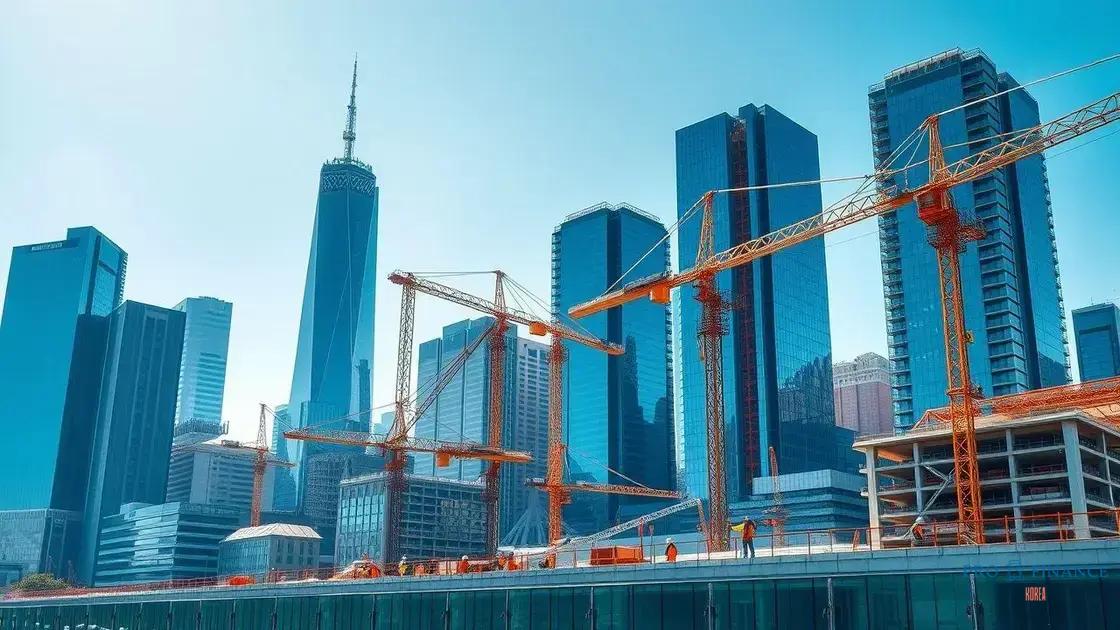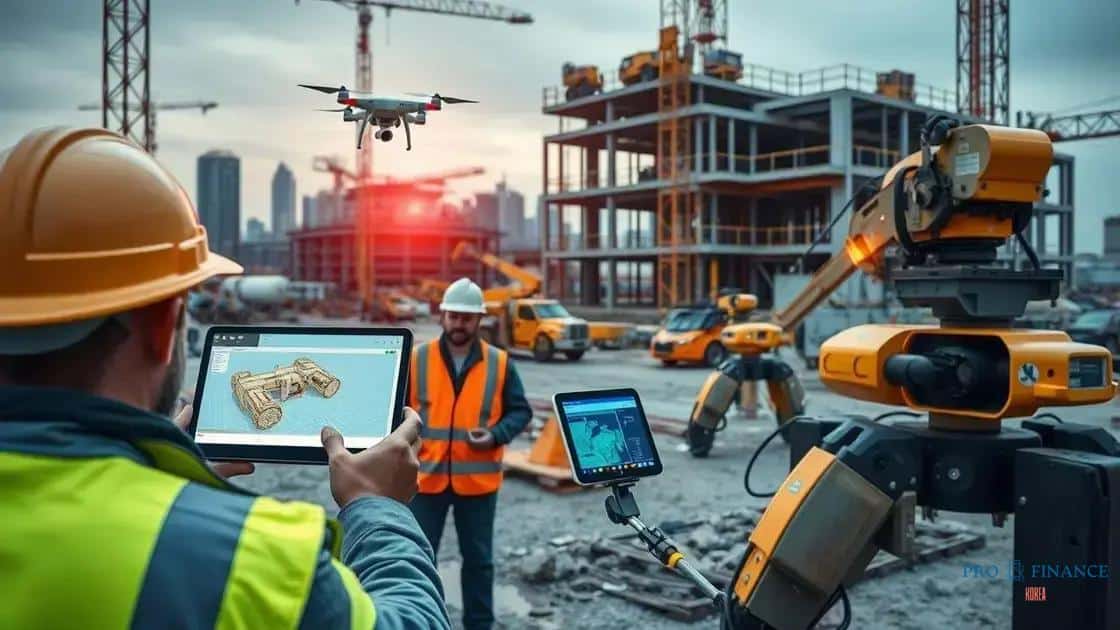Global investment in infrastructure projects for 2025

Global investment in infrastructure projects for 2025 faces challenges like funding constraints, regulatory hurdles, and labor shortages while emphasizing technology and sustainability to meet future demands.
Global investment in infrastructure projects for 2025 is gaining momentum, promising to transform economies and improve lives. Are you curious about what that means for us all? Let’s dive into how these advancements could shape our future.
Current trends in global infrastructure investment
The world is experiencing rapid changes in infrastructure investment. With new technologies and growing populations, the focus is shifting toward building more sustainable and efficient systems.
Among the most prominent trends is the rise of green technologies. Governments and private companies are increasingly prioritizing eco-friendly initiatives. This shift leads to cleaner energy sources and reduced carbon footprints.
Technological Advancements
Technological advancements continue to reshape how we view infrastructure. Smart city solutions use data to improve traffic flow, reduce energy consumption, and enhance public safety. Innovative construction methods, such as 3D printing, also contribute to the efficiency of building processes.
Investment Shifts
Another trend is the shift of funds towards public-private partnerships (PPPs). These collaborations allow for better resource allocation and lower financial risks. As governments face budget constraints, PPPs enable the execution of large projects without overextending public resources.
- Improved efficiency through collaboration
- Reduced risk for public sectors
- Access to private sector innovations
In addition to these trends, we see increasing investment in digital infrastructure. As the world becomes more connected, the demand for robust digital networks expands. High-speed internet and cloud computing are vital for both economic growth and social development.
Sustainability Focus
The emphasis on sustainability is driving investment in public transportation systems. Cities across the globe are enhancing their public transport options to include electric buses and expanded rail lines. This not only promotes environmental health but also reduces congestion and saves commuters’ time.
- Investment in electric and efficient public transport
- Expansion of bicycle lanes and pedestrian areas
- Increased funding for renewable energy projects
Understanding these current trends in global infrastructure investment can help stakeholders make informed decisions. As investments shift, those who adapt to these changes will be positioned for success.
Impact of technology on infrastructure projects

The impact of technology on infrastructure projects is transforming how these initiatives are planned and executed. Cutting-edge tools are enhancing efficiency, reducing costs, and improving outcomes.
One major influence is the use of Building Information Modeling (BIM). This technology allows engineers and architects to create 3D models of projects before construction begins. By identifying issues early, teams can prevent costly mistakes.
Smart Infrastructure Solutions
Smart infrastructure is another exciting development. This concept involves integrating sensors and data analytics into structures. For instance, bridges and roads can now collect data on stress and wear. This information helps in timely maintenance, extending the lifespan of these assets.
- Real-time monitoring for quicker repairs
- Improved safety through data-driven insights
- Enhanced energy efficiency with smart grids
Additionally, the rise of drones in surveying and inspection is revolutionizing the industry. These unmanned aerial vehicles provide accurate data quickly. They can cover large areas more efficiently than traditional methods, allowing for better planning and decision-making.
Automation and Robotics
Automation and robotics are also making waves in construction. Robots can perform repetitive tasks, such as laying bricks or painting, which frees up human workers for more complex duties. This not only speeds up project completion but also improves safety on job sites.
- Increased accuracy with robotic assistance
- Reduced labor costs through automation
- Less physical risk for workers
As we explore the impact of technology on infrastructure projects, it’s clear that future developments will likely incorporate even more advanced innovations. Embracing these changes is essential for staying competitive and meeting the growing demands of our communities.
Sustainable practices in new infrastructure
Sustainable practices in new infrastructure projects are essential for creating a better future. These practices help to minimize harm to the environment while supporting economic growth.
One key approach is the use of renewable materials. Builders are increasingly choosing materials like reclaimed wood and recycled concrete. These options reduce waste and lower the carbon footprint of new constructions.
Energy Efficiency
Incorporating energy-efficient technologies is another critical component. Smart systems can optimize energy usage in buildings, leading to lower utility costs and reduced environmental impact. Examples include LED lighting and advanced HVAC systems that adjust based on occupancy.
- Lower energy bills for building owners
- Enhanced comfort for occupants
- Reduction of greenhouse gas emissions
Additionally, many infrastructure projects now include green spaces. Parks and green roofs assist in biodiversity while improving air quality. Integrating nature into urban settings can also enhance mental well-being for residents.
Water Conservation
Water conservation techniques are vital in sustainable infrastructure. Implementing systems for rainwater harvesting helps to reduce dependency on municipal water supply while managing stormwater runoff effectively. These systems can be combined in urban designs to create a resilient infrastructure.
- Use of permeable pavements to reduce flooding
- Installation of drought-resistant landscaping
- Utilization of gray water recycling systems
As we explore sustainable practices in new infrastructure, it’s clear that these strategies not only benefit the environment but also enhance the resilience and livability of our communities. Incorporating these practices can pave the way for a greener and smarter future.
Key players in the 2025 infrastructure market

Key players in the 2025 infrastructure market are shaping how projects will be developed and financed. Understanding who these players are can provide insights into future trends and developments in the industry.
One of the most significant players is the government. National and local authorities set regulations, provide funding, and often lead major infrastructure projects. Their priorities will directly influence the types of projects that get off the ground.
Private Sector Influence
Another critical group is the private sector. Companies involved in construction, engineering, and technology play a vital role in implementing initiatives. They bring innovations, efficiency, and investment that can accelerate project completion.
- Leading engineering firms that design structures
- Construction companies that execute projects
- Technology firms providing smart solutions
Additionally, financial institutions are crucial. Banks and investors provide the necessary capital to fund major infrastructure projects. They assess risks and returns, influencing which projects are viable and receive backing.
Global Organizations
Global organizations also impact infrastructure development. Institutions like the World Bank and International Monetary Fund (IMF) offer funds and expertise for large-scale projects, especially in developing countries. Their focus on sustainability also aligns with modern infrastructure needs.
- Funding for projects in emerging markets
- Support for sustainable infrastructure practices
- Guidelines for best practices in project development
Lastly, technology companies increasingly join the conversation. As infrastructure relies more on tech solutions, companies involved in AI, IoT, and data analytics become vital partners in creating efficient and resilient systems.
Projected challenges for infrastructure investments
Projected challenges for infrastructure investments are becoming more evident as we approach 2025. As demand grows, so do the obstacles that investors and developers must navigate. Understanding these challenges is essential for successful project planning.
One significant challenge is funding and financing. With budgets tightening, securing adequate investment becomes increasingly difficult. Many projects rely on public funding, which can be limited due to economic conditions. This situation often leads to a race for resources among competing projects.
Regulatory Hurdles
Another challenge comes from regulatory requirements. Navigating complex regulations can delay projects. Compliance with local, state, and federal laws often requires extensive documentation and environmental assessments, which can extend timelines and increase costs.
- Lengthy permitting processes can stall projects
- Compliance costs can erode budgets
- Variability in regulations across regions
Additionally, labor shortages pose a significant obstacle. With a growing demand for infrastructure, the construction industry is facing a scarcity of skilled workers. This shortage can lead to delays and increased labor costs, affecting project completion timelines.
Technological Integration
As technology rapidly evolves, keeping up with the latest innovations can be challenging. Adopting new technologies, such as smart infrastructure solutions, requires significant investment and training. Projects must be adaptable to leverage these advancements effectively while managing their costs.
- Balancing technology and traditional methods
- Investment in workforce training for new technology
- Handling integration challenges with existing systems
Finally, environmental concerns are becoming increasingly important in infrastructure development. Climate change effects, such as flooding and severe weather, can impact project viability. Ensuring that investments are sustainable and resilient is now a top priority for many stakeholders.
In conclusion, the landscape of infrastructure investment is evolving fast, with many challenges alongside exciting opportunities. Understanding the key players, embracing technology, and focusing on sustainability are crucial for success. By addressing funding issues, regulatory hurdles, and labor shortages, stakeholders can navigate the complexities of the market. Overall, a commitment to innovation and collaboration will pave the way for resilient infrastructure that meets future needs.
FAQ – Frequently Asked Questions about Infrastructure Investment
What are the main challenges for infrastructure investments?
Key challenges include securing funding, navigating regulatory hurdles, and addressing labor shortages in the construction industry.
How can technology improve infrastructure projects?
Technology can enhance efficiency through smart solutions, such as data analytics and automated systems, allowing for quicker decision-making and project management.
Why is sustainability important in infrastructure development?
Sustainability ensures that projects minimize environmental impact, utilize eco-friendly materials, and promote resilience against climate change effects.
Who are the key players in infrastructure investment?
Key players include government entities, private construction firms, financial institutions, and global organizations that provide funding and expertise.






